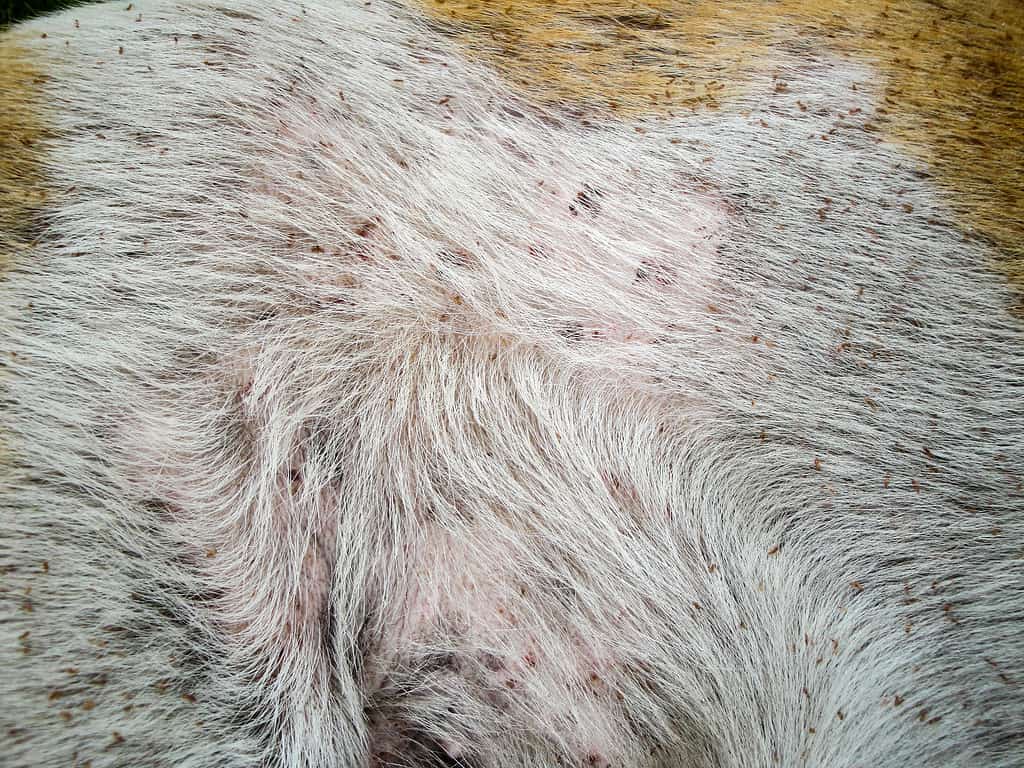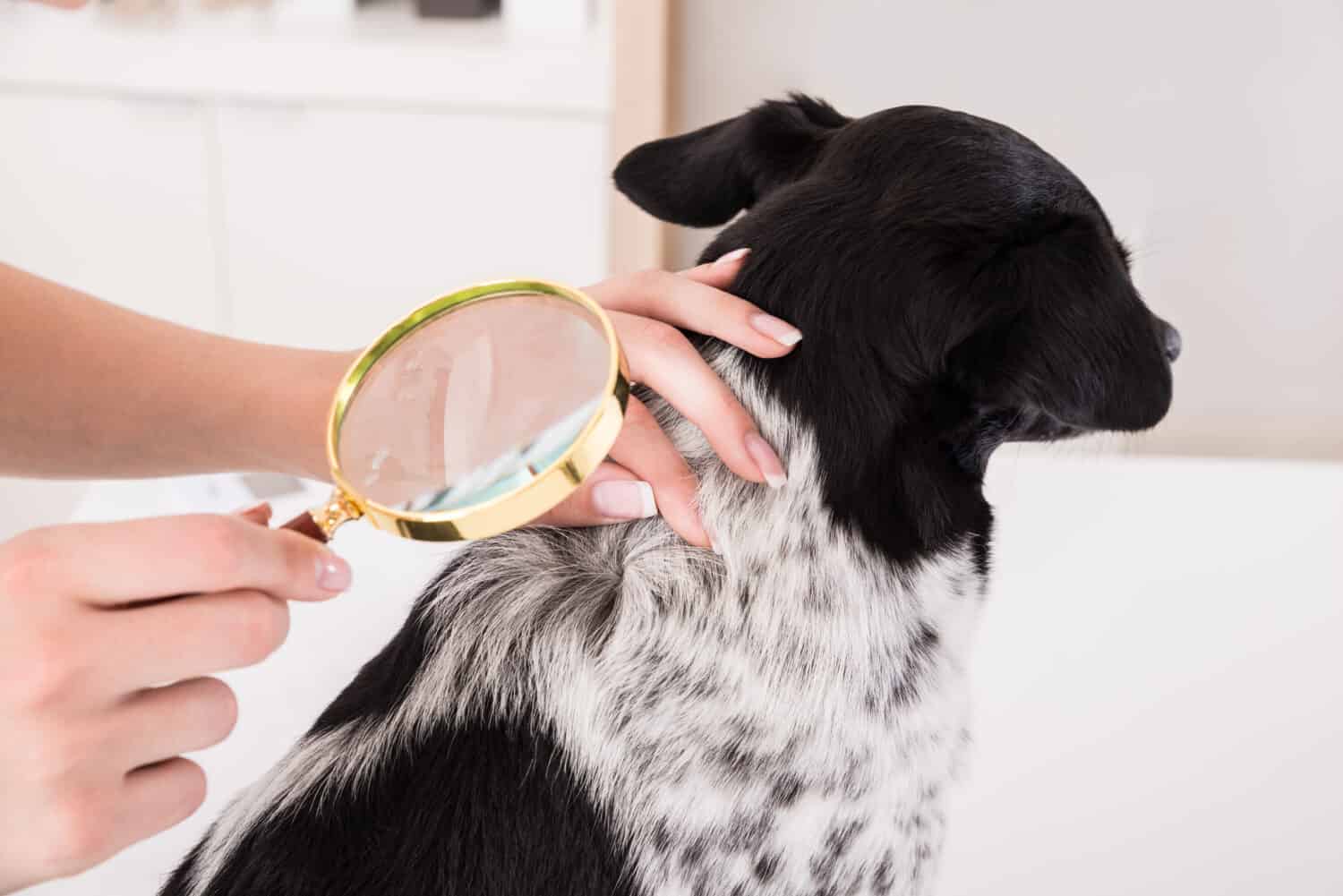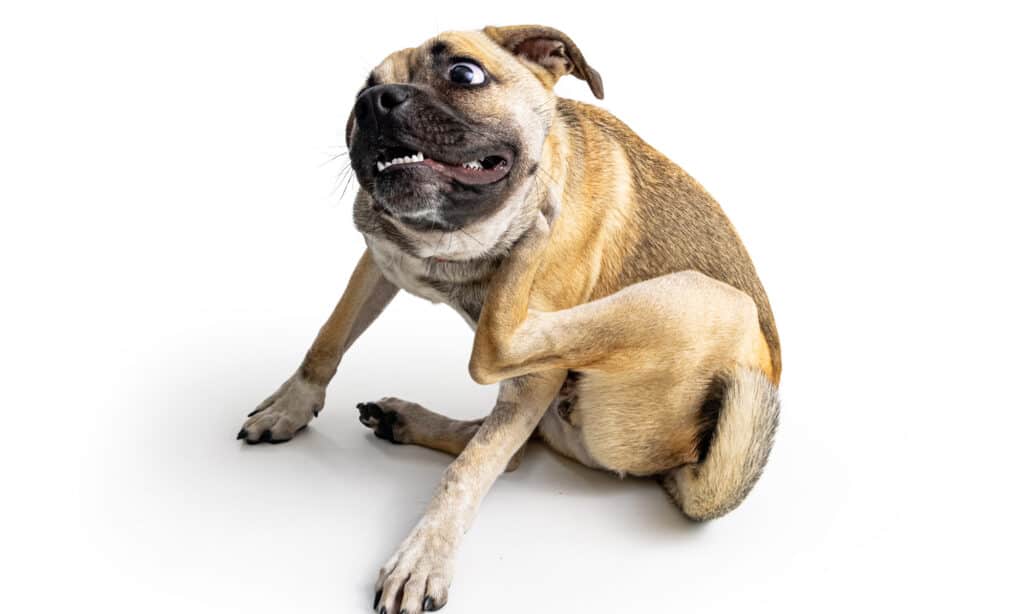If you’ve dealt with a lice infestation in your home, you may be wondering if you can spread lice to your dog. Lice are difficult enough to deal with without the worry of them infecting your furry friends. To know whether or not dogs can get lice from humans, we need to know a bit more about what lice are.
Lice are insects that live on the hair of humans and animals. They are found on every continent on Earth. They are part of the group Phthiraptera, which includes 5,000 species. There are two main types — chewing and sucking lice. The chewing type feed on mammals and birds, eating feathers, hair, and pieces of skin. Sucking lice feed only on mammals, and drink their blood after penetrating through their host’s skin.
Both chewing and sucking lice are species-specific. This means that dogs cannot get lice from humans, nor humans get lice from dogs. However, dogs can certainly get lice, and there are three species that can infect them — Linognathus setosus, a sucking louse, Trichodectes canis, a chewing louse, and Heterodoxus spiniger, a rare chewing louse. These species of dog lice are comprised of small, flightless, six-legged insects that feed off of their hosts.
Symptoms of Dog Lice

Dogs can get lice, and their symptoms will be similar to lice on humans, with prevalent itching and discomfort.
©Photo-Vista.de/Shutterstock.com
Similarly to humans, dogs who have lice will experience itching and discomfort. You may notice excessive scratching, coat issues (matting, dryness, or roughness), and hair loss. In more severe stages of lice infestation, you may see small wounds or skin infections on your dog.
If you think your dog has lice, it’s very easy to check for them. They are about the size of a sesame seed and can be found by the human eye. They range from yellow to medium brown in color, which differentiates them from fleas, which are dark black. Fleas are also a bit smaller in size.
Look through your dog’s coat by parting it with a flea comb or your hands. Chewing lice move consistently and sucking lice will usually embed into the skin and stay in place. You may also see small, white specks in the coat. While sometimes mistaken for dandruff, these could also be lice eggs, or nits. If you run a flea comb through your pet’s coat and the specks stick, it is more likely that they are nits than dandruff.
Can They Hurt Dogs?

Lice on dogs can be a serious problem if not promptly treated.
©Drnooker/Shutterstock.com
Aside from the itching and discomfort that lice cause dogs, they can negatively affect them in other ways. Lice can cause bacterial infections in the skin from all of the itching. They can also cause tapeworms if they are ingested. This is why it’s key to address an infestation quickly before it causes other health issues.
Where Does Dog Lice Come From?

Lice are species-specific, so if your dog has lice, it likely came from another dog.
©Andrey_Popov/Shutterstock.com
If you’ve recently found that your dog has an infestation, you’re probably wondering where they got it from. Most of the time lice are passed from one infected dog to another. Remember that they are species-specific, so they wouldn’t be passed from a human or even a cat.
Lice cannot fly and spread through jumping and crawling. This usually means that there is some kind of direct contact between animals that spread the infection. In some cases, there is no direct contact.
Bedding, grooming tools, dog outfits, and accessories can all be host to lice for a short time. So if you buy used bedding, clothing, collars, or anything else for your pup, make sure to wash it first. It’s worth noting that adult lice only live for a few days without a host, so areas with a consistent presence of dogs will have more of a chance of having lice. This leaves dog parks, kennels, pet-sitting facilities, and other areas where dogs visit regularly at risk.
Understand the Life Cycle

The eggs of lice hatch after just about a week.
©Dmitrii Pridannikov/Shutterstock.com
Lice can reproduce quickly, which is how they spread on a dog’s coat and to other dogs. The life cycle begins with female lice laying eggs. The eggs are attached with a sticky fluid that keeps them glued to your dog’s fur until hatching. Eggs are very difficult to remove and usually stay in place during brushing and baths.
After about one week, the eggs hatch into nymphs, which are immature lice. They appear physically similar to adult lice but are extremely small. In the next two to three weeks they mature into adult lice that can reproduce. Adult females will lay eggs daily for the rest of their lives, which range from 30 to 45 days. Because of their quick reproductive habits and difficulty removing, it’s crucial to treat dog lice with the right products.
Solutions to Canine Lice

When trying to rid your dog of fleas, remember to only use one flea/tick/lice treatment at once.
©iStock.com/adogslifephoto
Now that you’ve discovered your furry friend has lice, what should you do? Luckily there are many treatments for dog lice. If your dog is on a monthly flea pill, you may be wondering if it can prevent a lice infestation. Most flea medications are also slightly effective against lice, though not entirely. Because of this, there are not many pills that claim to be preventative against lice infections. However, even with lower effectiveness ratings, lice are rarely found on dogs who are given flea and tick prevention pills. They are usually seen on older dogs, strays, and those with existing health problems.
It may be a better choice to switch to a topical or collar form of prevention if your dog is having issues with lice. Remember that only one form of flea, tick, and lice prevention should be used at once, so don’t treat the infection with a collar and a pill. You may be given additional medicine by your vet for an active infection, but be sure to inform them of what your dog is already taking.
If you prefer a collar, the Seresto Flea & Tick Collar for Dogs is a great choice. It also protects against lice and lasts for eight months of protection at a reasonable price. There are also topical forms of lice prevention. The best option for this is Frontline Plus Flea & Tick Spot Treatment. It comes with six monthly doses of flea, tick, and lice-preventing treatment that is applied to the skin at the back of your dog’s neck.
Using Shampoo to Treat an Active Infection

Some shampoos can help eradicate lice.
©Jaromir Chalabala/Shutterstock.com
Another great choice for removing an active infestation is lice shampoo. If your dog has had an infection for a long time, you may need to remove matted fur and debris from their coat. Do this by running a comb through their fur and cutting out any mats. Remember that lice and eggs will typically cling to a dog’s fur so trimming may be the only option to fully remove them. If you are able to, shaving the dog’s fur can also drastically help to prevent lice from returning. This also makes it easier to keep track visually of the infestation.
After brushing and trimming, place all of the combs, scissors, and grooming tools in an insecticide or dog lice shampoo. Then bathe your dog with the shampoo as well. One great option for removing lice is Adams Plus Flea & Tick Shampoo with Precor. It protects against and prevents lice, fleas, and ticks and doesn’t require a prescription. It is also a multi-animal shampoo, as it can be used on cats and dogs.
It’s important to remember the lice life cycle when treating your pup with shampoo. Adult lice should be killed quickly after shampoo application. However, eggs are very sticky and are sometimes not affected as soon, often not until after they hatch. For this reason, it’s recommended to use the shampoo every seven to ten days. Doing this for about a month should remove any of the remaining lice.
If you’ve already tried shampoo or one of the other methods aforementioned, it may be time to take your dog to the vet. There are many more lice treatments that can be prescribed to your pet. Your vet can help come up with a plan to safely and quickly eradicate the little pests.
The photo featured at the top of this post is © Sommai Iam/Shutterstock.com
Ready to discover the top 10 cutest dog breeds in the entire world?
How about the fastest dogs, the largest dogs and those that are -- quite frankly -- just the kindest dogs on the planet? Each day, AZ Animals sends out lists just like this to our thousands of email subscribers. And the best part? It's FREE. Join today by entering your email below.
Thank you for reading! Have some feedback for us? Contact the AZ Animals editorial team.






